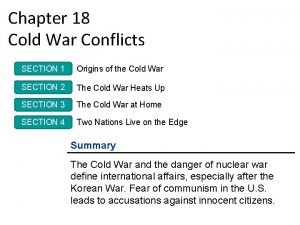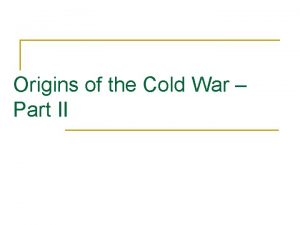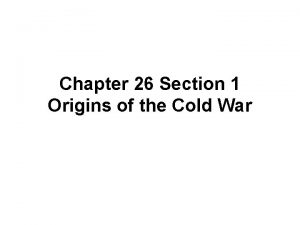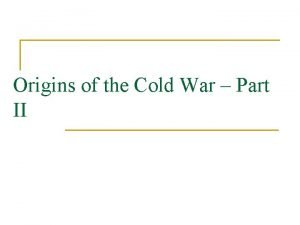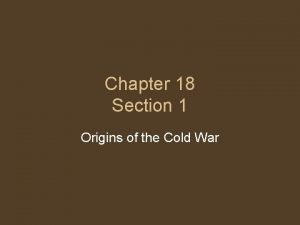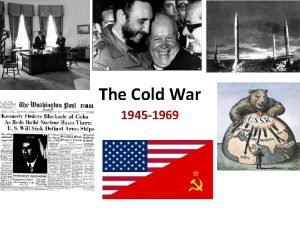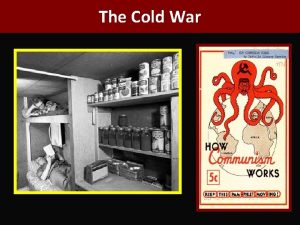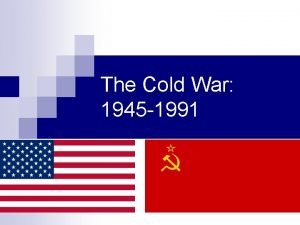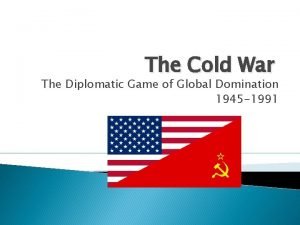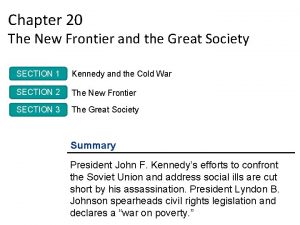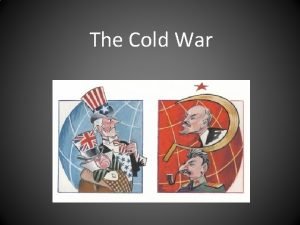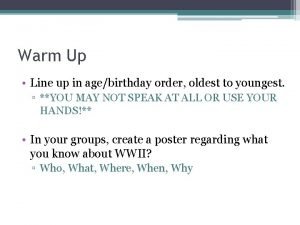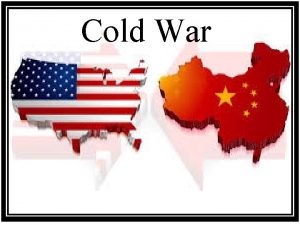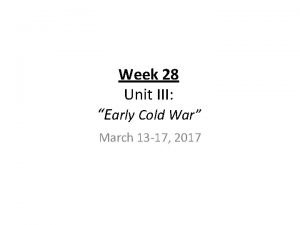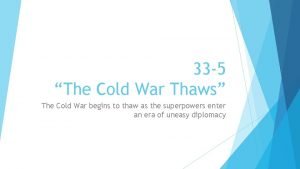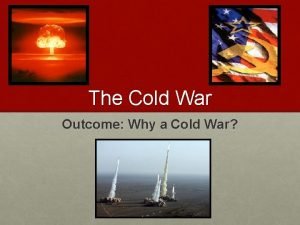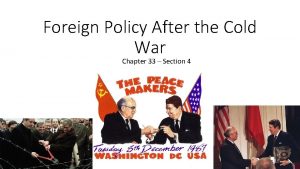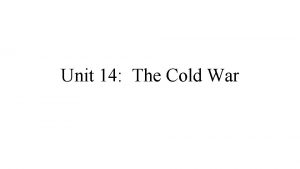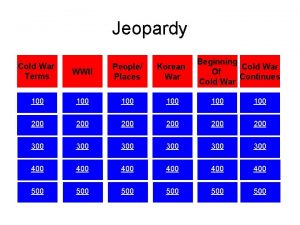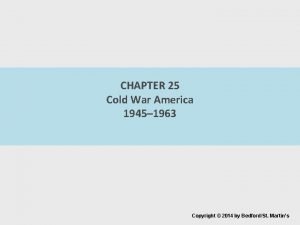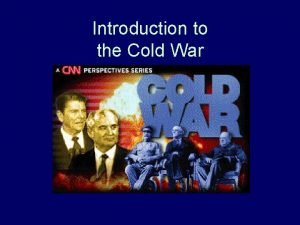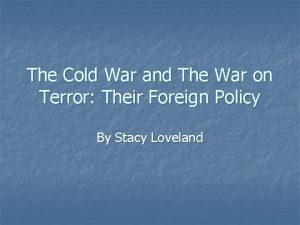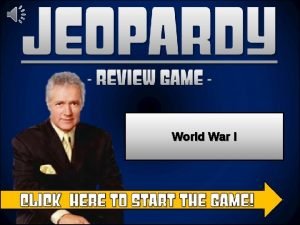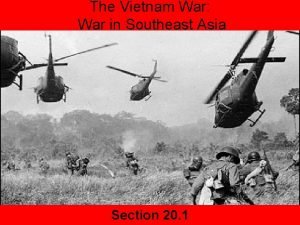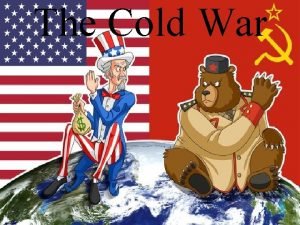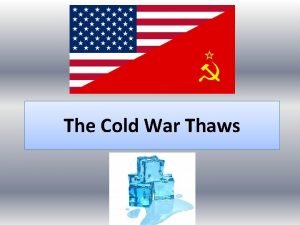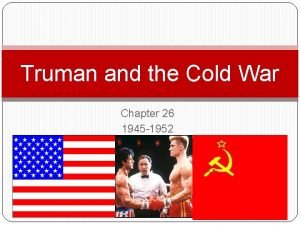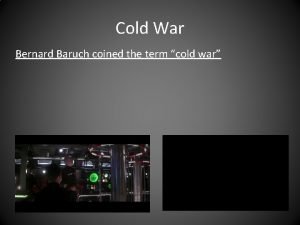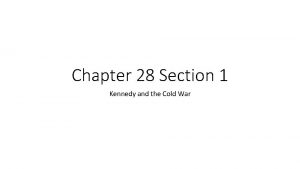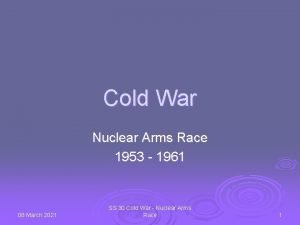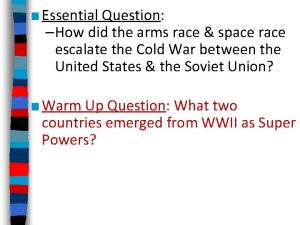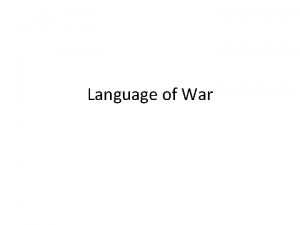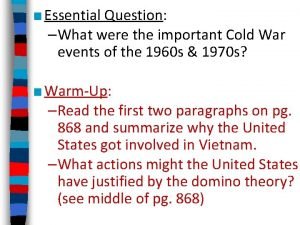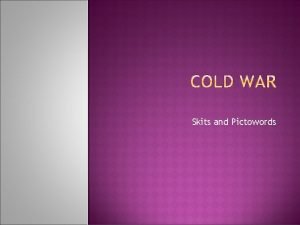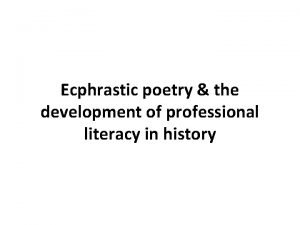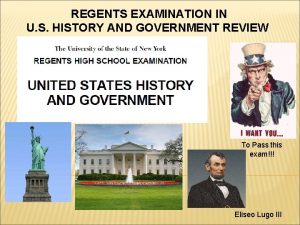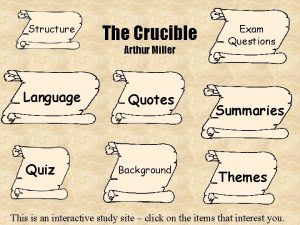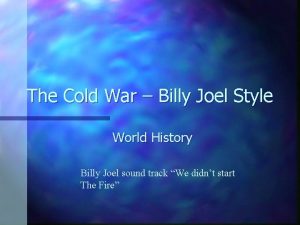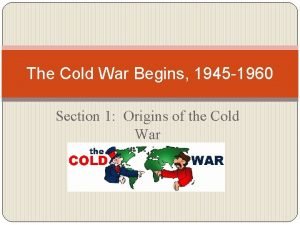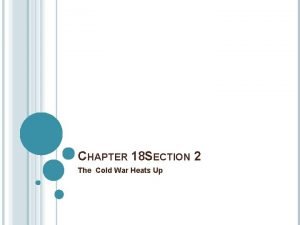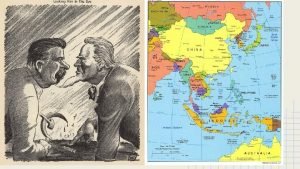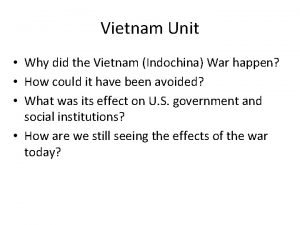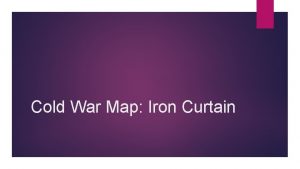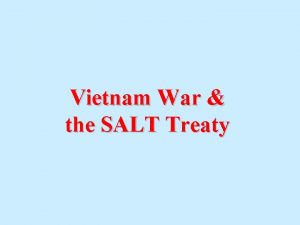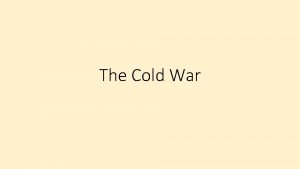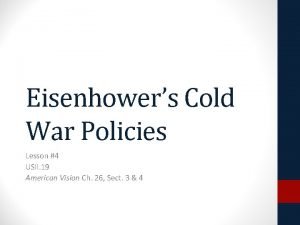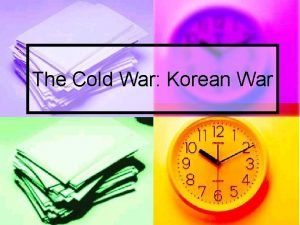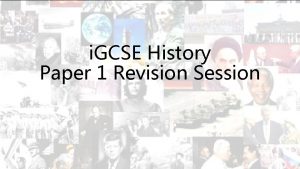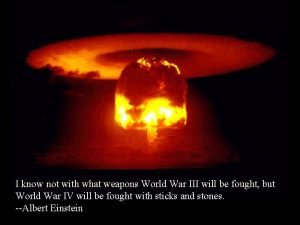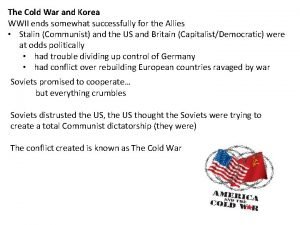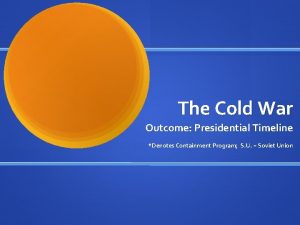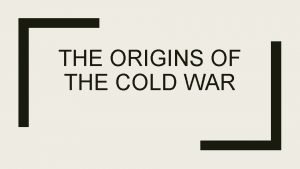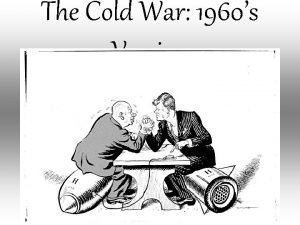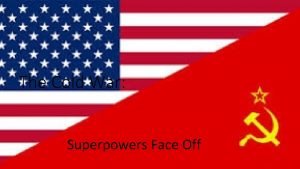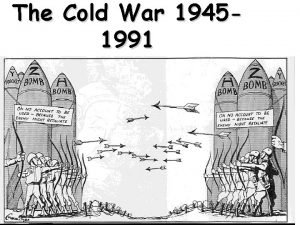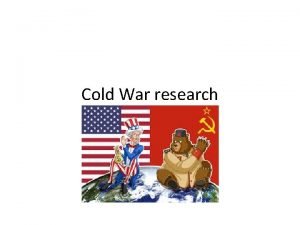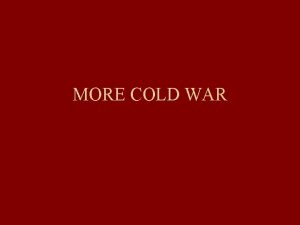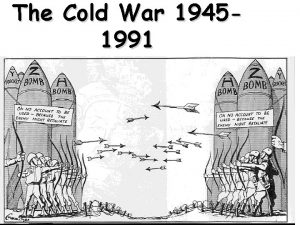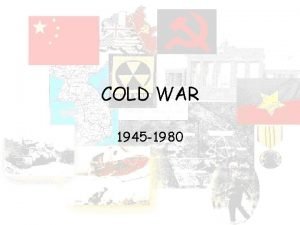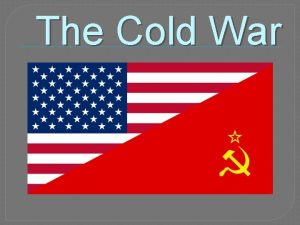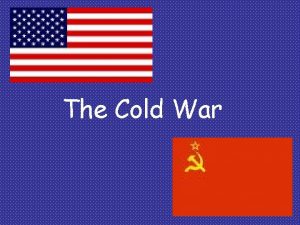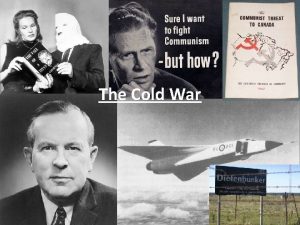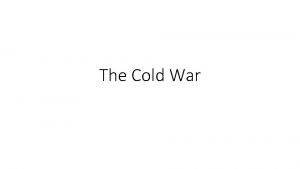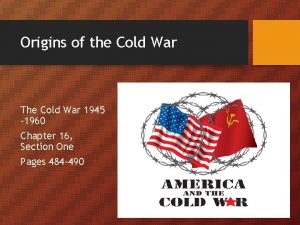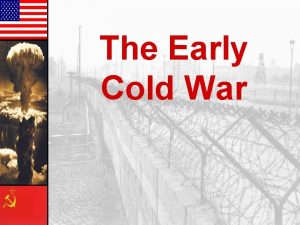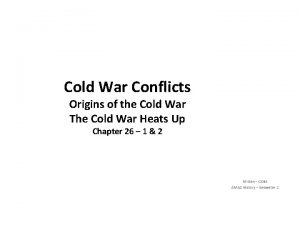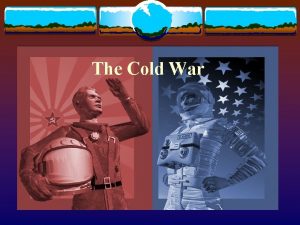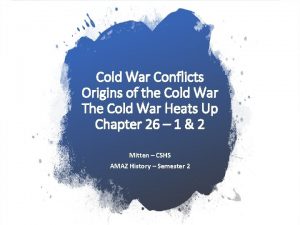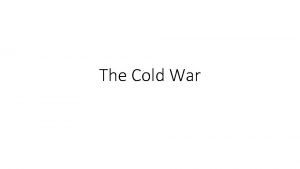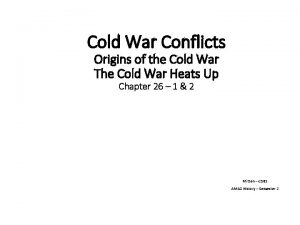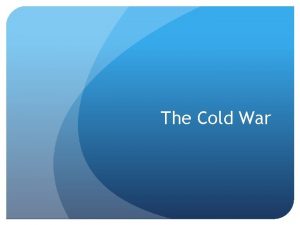Origins of the Cold War Origins of the


























































- Slides: 58

Origins of the Cold War

Origins of the Cold War ¢ The cold war began with mistrust between the Soviet Union (red) and the western democracies (blue).

SOVIET PERSPECTIVE

1. Western Opposition to Bolsheviks ¢ In 1919, Russia’s former World War I allies (Britain, France and the United States) joined the "White Russians" to fight off the Bolsheviks following the revolution. ¢ This intervention failed and the Red Army of the Bolsheviks secured the power of the new Soviet state. The young USSR government never quite trusted the western democracies after that.

3. Disregard for Soviet Diplomatic Goals l The western democracies did not invite the Soviet Union to participate in the World War I peace talks or the League of Nations. l Remember western powers supported Poland in the Soviet-Polish Crisis

4. West Did Not Aid in Spanish Civil War l The west did not aid the Republicans fighting the fascists in the Spanish Civil War.

Western Delay in Opening 2 nd Front ¢ Stalin believed that the western allies were dragging their feet in opening up the "second front" in Europe, so necessary to take the pressure off the struggling Soviet forces in the east.

Development of the Cold War ¢ Soviet Union l They felt that they had won World War II. They had sacrificed the most (25 million vs. 300, 000 total dead) and deserved the “spoils of war. ” They had lost land after WWI because they left the winning side; now they wanted to gain land because they had won. l They wanted to economically raid Eastern Europe to recoup their expenses during the war. l They saw the U. S. as a threat to their way of life; especially after the U. S. development of atomic weapons. l Stalin gave a speech and said that “communism and capitalism cannot coexist in the world. ”

WESTERN PERSPECTIVE

1. Fear of Socialism l The avowed purpose of the International Communist Party was to secure world wide communist revolution. There was a great fear of socialism in Europe and America.

2. Soviet Annexation of Eastern Poland l The Soviets negotiated an agreement with Hitler and annexed eastern Poland. l. By the end of the war Britain and the United States distrusted the Soviet motives in eastern Europe. ¢This mutual distrust was suppressed during World War II when for practical reasons (the common enemy of Hitler's Germany) the western allies and the Soviet Union became uneasy allies.

3. Constant Abandonment ¢ Different governments ¢ ¢ Different Religions ¢ Different Economic ¢ systems ¢ ¢ Different values ¢ ¢ ¢ Three Emperor’s League Moroccan Crisis I and II Treaty of Brest. Litovsk Treaty of Rapallo Nazi-Soviet Non. Aggression Pact Comintern

4. Soviet Consolidation of Power ¢ Between 1945 -1948 the Soviets under Stalin consolidated their power in Eastern Europe. l l Poland, East Germany, Czechoslovakia, Romania, Bulgaria, Hungary became part of the "Soviet Bloc" – or "satellite system. " Within the communist parties of these countries there were purges to remove national communists - one in four were removed. ¢ Stalin delivered his “Two Hostile Camps” speech in which he declared that Communism and Capitalism cannot coexist. ¢ Winston Churchill delivered his famous “Fulton Speech” in which he declared an ‘iron curtain’ was descending on Eastern Europe

5. Yugoslavia Remained Independent ¢ ¢ ¢ Yugoslavia under Tito was an exception to Soviet control. Tito and Stalin were constantly at “odds” Yugoslavia practiced "national communism" and was able to remain independent of Soviet control.

6. Soviet Desire for Friendly Gov’ts (Yalta) ¢ Stalin was open about wanting "friendly governments" in Eastern Europe to protect his country's western frontier from another invasion like the invasion so recently experienced by Germany. ¢ Finally, it was agreed that independent governments would be established in these lands, and that elections would be free, but the governments would be "friendly to the Soviet Union. " ¢ Roosevelt agreed to these conditions because he needed Soviet support in Japan

7. Strained Relations at Potsdam ¢ ¢ When the allies met again at Potsdam in July of 1945, relations were more strained. Roosevelt had been replaced by Truman, who was not inclined to humor Stalin once he found out that there had been a successful test of the atomic bomb. America no longer desperately needed Soviet help in the war against Japan. America had halted aid to the Soviet Union because of concerns over Russian behavior in the East.

Early Cold War Policies Outline of Chapter 9, Section 2 Due Friday. Don’t forget to work up to the “End of the Cold War” This section is about the crises. We will not discuss these. Support Marshall Plan? Edsitement lesson

The Truman Doctrine (1947) ¢ Reasoning Threatened by Communist influence in Turkey and Greece l “Two hostile camps” speech l Financial aid “to support free peoples who are resisting attempted subjugation” ¢ Sent $400 million worth of war supplies to Greece and helped push out Communism ¢ The Truman Doctrine marked a new level of American commitment to a Cold War. ¢

Provisions of the Truman Doctrine ¢ ¢ ¢ "I believe that it must be the policy of the United States to support free peoples who are resisting attempted subjugation by armed minorities or by outside pressures. I believe that we must assist free peoples to work out their own destinies in their own way. I believe that our help should be primarily through economic and financial aid which is essential to economic stability and orderly political processes. "

The Policy of Containment ¢ ¢ ¢ Definition: l By applying firm diplomatic, economic, and military counterpressure, the United States could block Soviet aggression. Formulated by George F. Kennan as a way to stop Soviet expansion without having to go to war. Ironically, the Soviets were looking for insulation from the Capitalist West.

The Truman Doctrine: March 12, 1947 Walter La. Feber contends that the Truman Doctrine marks the American declaration. Four reasons it was a milestone: 1. It marked the point at which Truman used the American fear of communism both at home and abroad to convince Americans they must embark upon a Cold War foreign policy 2. Congress was giving the President great powers to wage this Cold War as he saw fit. Truman's personal popularity began spiraling upward after his speech

For the first time in the postwar era, Americans massively intervened in another nation's civil war. Intervention was justified on the basis of anticommunism. In the future, America would intervene in similar wars for supposedly the same reason 4. Truman used the doctrine to justify a gigantic aid program to prevent the collapse of the European and American economies. The President's arguments about anticommunism were confusing, for the Western economies would have been in grave difficulties whether or not communism existed. The complicated problems of reconstruction and U. S. dependence on world trade were not well understood by Americans, but they easily comprehended anticommunism. So Americans embarked upon the Cold War for the good reasons given in the Truman Doctrine, which they understood, and for real reasons which they did not understand.

¢ Stalin saw the Marshall Plan as a significant threat to Soviet control of Eastern Europe l l l believed that economic integration with the West would allow these countries to escape Soviet guidance. Stalin was right: The Americans shared this view and hoped that economic aid could counter the growing Soviet influence. Delegates were not surprised, therefore, when the Czechoslovakian and Polish delegations were prevented from attending the Paris meeting– They were arrested The other Eastern European states immediately rejected the offer. Finland also declined in order to avoid antagonizing the Soviets. The Soviet Union's "alternative" to the Marshall plan, which was purported to involve Soviet subsidies and trade with eastern Europe, became known as the Molotov Plan, and later, the COMECON.

¢ The Cominform (Communist Information Bureau) is the common name for what was officially referred to as the Information Bureau of the Communist and Workers' Parties. l ¢ Founded in September, 1947 at a conference of Communist party leaders. l ¢ It was the first official forum of the international communist movement since the dissolution of the Comintern, and confirmed the new realities after World War II - including the creation of an Eastern Bloc. The Soviet leader Joseph Stalin called the conference in response to divergences among the eastern European governments on whether or not to attend the Paris Conference on Marshall Aid in July 1947. The intended purpose of the Cominform was to coordinate actions between Communist parties under Soviet direction. As a result, the Cominform acted as a tool of Soviet foreign policy and Stalinism.

The Marshall Plan (1947 -48) ¢ ¢ ¢ War damage and dislocation in Europe invited Communist influence Economic aid to all European countries offered in the European Recovery Program $17 billion to western Europe Soviets refused – The blame for dividing Europe fell on the Soviet union, not the United States. The Marshall Plan proved crucial to Western Europe’s economic recovery.

Austria 1948/49 ($ millions) 232 1949/50 ($ millions) 166 70 Cumulative ($ millions) 468 Belgium and Luxembourg 195 222 360 777 Denmark 103 87 195 385 France 1085 691 520 2296 West Germany 510 438 500 1448 Greece 175 156 45 376 Iceland 6 22 15 43 Ireland 88 45 0 133 Italy and Trieste 594 405 205 1204 Netherlands 471 302 355 1128 Norway 82 90 200 372 Portugal 0 0 70 70 Sweden 39 48 260 347 Switzerland 0 0 250 Turkey 28 59 50 137 United Kingdom 1316 921 1060 3297 Country Totals 4, 924 3, 652 1950/51 ($ millions) 4, 155 12, 731

The Molotov Plan The Soviets responded with their own version of the Marshall Plan in which the Soviets promised to aid any country that was under threat of Western imperialist encroachment. ¢ Established Com. Econ (open to all Communist countries including China, etc) ¢

NSC-68 ¢ The Containment Doctrine would later be expanded in 1949 in NSC-68, which called for a dramatic increase in defense spending ¢ From $13 billion to $50 billion a year, to be paid for with a large tax increase. ¢ NSC-68 served as the framework for American policy over the next 20 years.

Dividing Germany ¢ ¢ ¢ U. S. , Britain, and France merged their zones in 1948 to create an independent West German state. The Soviets responded by blockading land access to Berlin. The U. S. began a massive airlift of supplies that lasted almost a year. (7, 000 tons a day) In May 1949 Stalin lifted the blockade, conceding that he could not prevent the creation of West Germany. Thus, the creation of East and West Germany


North Atlantic Treaty Organization & the Warsaw Pact ¢ Stalin’s aggressive actions accelerated the American effort to use military means to contain Soviet ambitions. ¢ The U. S. joined with Canada, Britain, France, Belgium, the Netherlands, and Luxembourg to establish NATO, a mutual defense pact in 1949. ¢ Pledged signers to treat an attack against one as an attack against all. ¢ When West Germany joined NATO in 1955, the Soviet Union countered by creating its own alliance system in eastern Europe– the Warsaw Pact (1955)


The Cold War Heats Up: Proxy Wars Problems of the Atomic Age Russia detonated its first atom bomb in 1949. l Truman ordered construction of the hydrogen bomb. l ¢ Call for buildup of conventional forces to provide alternative to nuclear war. ¢ This launched an arms race/space race

MAD (War Games) Mutually Assured Destruction was designed to keep both sides from "pushing the button, " by giving both sides equality in "kill power. "

“Losing China” ¢ ¢ ¢ Truman was preoccupied with Europe. Chinese Revolution broke out and Soviets supported Mao Zedong- a Communist leader. US did not fully support Chang Kai-shek- the non-communist leader Sino-Soviet Treaty of Friendship and Alliance After “losing” China, the United States sought to shore up friendly Asian regimes. Domino Theory

The Korean War (1950 -53) ¢ Since World War II the country had been divided along the 38 th parallel l The North was controlled by the Communist government of Kim Il Sung l Soviet-backed troops from North Korea invaded U. S. -backed South Korea in June 1950.

The Korean War (1950 -53) ¢ The South by the dictatorship of Syngman Rhee. ¢ The confrontation between capitalist and Communist blocs turned into open military struggle.

The Korean War (1950 -53) ¢ Stalin had agreed to the North Korean attack, but promised only supplies. l ¢ He would eventually send pilots dressed in Chinese uniforms and using Chinese phrases over the radio Having already “lost” China, it was decided that the United States would fight the North Koreans. l l It would use enough force to deter aggression, but without provoking a larger war with the Soviet Union or China. The U. S. would not declare war. The United Nations sanctioned aid to South Korea as a “police action. ”

Side effects of the Korean War ¢ Truman also increased assistance to the French in Indochina, creating the Military Assistance Advisory Group for Indochina. l This was the start of America’s deepening involvement in Vietnam.

Military Developments ¢ Mac. Arthur pushed the North Koreans back to the 38 th Parallel. He then decided to invade the North in an effort to unify Korea l Chinese Communist “volunteers” entered the war and pushed U. S. back. l

Dismissal of Mac. Arthur ¢ ¢ Mac. Arthur wanted to blockade China and use Taiwanese Nationalists to invade mainland China. l He ordered China to make peace or be attacked. Truman removed Mac. Arthur from all his commands and replaced him with General Matthew Ridgway who gradually pushed back almost to original line.

End of war Snags in negotiations. ¢ Truce talks lasted for two years. ¢ Truce signed on July 27, 1953 ¢ Cost of the war ¢ l U. S. – 33, 000 deaths and 103, 000 wounded and missing. l S. Korean – 1 million l N. Korean and Chinese – about 1. 5 million

The Cold War in the 1950 s: USSR ¢ Nikita Khrushchev takes over after Stalin’s death in 1953. l ¢ He repudiates Stalin’s use of the vast Gulag (or labor camp complex) and attempts to separate Stalin’s “crimes” from true communism. Repression and Dissent Polish and Hungarian intellectuals and students held demonstrations calling for free elections, withdrawal of Soviet troops, etc. l 1956 – Soviet Crackdown in Hungary l • Soviet tanks were sent in to crush dissent. l Eastern Europe remained under Soviet control.

The Cold War in the 1950 s: USSR ¢ October 4, 1957 – USSR launched the first satellite, Sputnik, into orbit. l ¢ ¢ The Sputnik launch confirmed the Soviet Union’s superpower status. Two months earlier they had tested an intercontinental ballistic missile (ICBM). Khrushchev – “We will bury you”

The Cold War in the 1950 s: U. S. ¢ ¢ ¢ Dwight Eisenhower takes over from Truman in 1953. l Democrats charged Republicans for “missile gap” l Eisenhower responded. Enlarged defense spending; National Aeronautics and Space Administration (NASA) By 1962 -63, the U. S. had 450 missiles and 2, 000 bombers capable at striking the Soviet Union, compared to 50 -100 ICBMS and 200 bombers that could reach the U. S.

The Third World ¢ In the 1950 s, French intellectuals coined the term “Third World” to describe the efforts of countries seeking a “third way” between Western capitalism and Soviet communism. By the early 1960 s, the term had come to identify a large bloc of countries from Asia, Africa, and Latin America. l Charting a “third way” proved difficult, both economically and politically. Both the Soviets and the Americans saw the Third World as “underdeveloped. ” l

The Third World ¢ By the middle of the 1960 s, as the euphoria of decolonization evaporated and new states found themselves mired in debt and dependency, many Third World nations fell into dictatorship and authoritarian rule. ¢ Middle East and Latin America

The Cold War in the 1960 s ¢ ¢ ¢ Khrushchev: “You don’t like Communism, we don’t like Capitalism. There is only one way: peaceful coexistence” American U-2 spy plane shot down by Soviets in 1960. In 1961, the Soviet begun construction of the Berlin Wall, which cut off movement between East and West Berlin and became a symbol of the eroding relations between the Soviet Union and the United States.

The Berlin Wall ¢ In 1961 East Germany built a wall to separate East Berlin from West Berlin, isolating West Berlin within East Germany. This wall which divided east and west became the symbol of the tensions dividing the world during the cold war.

“Ich bin ein Berliner” ¢ John F. Kennedy went to Berlin on June 26, 1963, to show support for the West Berliners. He told them: “All free men, wherever they may live, are citizens of Berlin and, therefore, as a free man, I take pride in the words ‘Ich bin ein Berliner. ’”

The Cuban Missile Crisis ¢ In 1962, Fidel Castro of Cuba (communist revolutionary who hated U. S. ) gave permission to the Soviet Union to build missile bases in Cuba in response to a missile site we had in Turkey (no one really knew about this) Fidel Castro and Nikita Khruschev

U-2 Reconnaissance Flights ¢ The United States U-2 reconaissance flights photographed the sites under construction.

Soviet tanks in Havana meant a Communist presence in the western hemisphere

The Response: A Blockade of Cuba ¢ President Kennedy's advisers were divided on the best course of action. Many wanted an air strike to take out the missiles; others wanted a blockade. Kennedy decided on the blockade and US ships surrounded the island, refusing to allow Soviet ships bringing supplies to get through.

Brinkmanship: The World on the Brink of War (13 Days) ¢ The world held its breath as the Soviet ships approached the blockade. Many feared that this was "it, " the long awaited and much feared nuclear war.

Missiles Were Removed from Cuba ¢ After a series of telegrams between Khruschev and Kennedy and a secret promise to remove American missiles in Turkey offered by Robert Kennedy, war was avoided, and the missiles were removed from Cuba.

Sino-Soviet Split -- 1961 ¢ Mao Zedong broke official relations with the Soviet Union because of ideologoical differences of Marxism ¢ Mao felt Khruschev was not aggressively pushing for a Communist revolution ¢ China had their own atomic weapons and felt they were stronger than the Soviet Union. Wanted their own recognition. Withdrew from Comecon and Comintern. ¢ Bad for Soviets… suprisingly good for the U. S.

Detente A thawing of relations between East and West. The whole world was rattled by the Cuban Missile Crisis ¢ Kennedy’s assassination brought LBJ to the presidency. ¢ He was internally focused on the Civil Rights Movement ¢ Sino Soviet split broke the relationship between two powers. ¢ U. S. did not challenge China tensions eased (Ping Pong) ¢ Unfortunately, Vietnam was heating up
 The cold war lesson 1 the cold war begins
The cold war lesson 1 the cold war begins Origins of the cold war chapter 18 section 1
Origins of the cold war chapter 18 section 1 Origins of the cold war
Origins of the cold war Chapter 26 section 1 origins of the cold war
Chapter 26 section 1 origins of the cold war Origins of the cold war
Origins of the cold war Origins of the cold war chapter 18 section 1
Origins of the cold war chapter 18 section 1 Proxy wars during the cold war
Proxy wars during the cold war The cold war heats up: 1945 - 1969
The cold war heats up: 1945 - 1969 Characteristics of the cold war
Characteristics of the cold war The cold war map
The cold war map U2
U2 Chapter 20 section 1 kennedy and the cold war
Chapter 20 section 1 kennedy and the cold war Characteristics of cold war
Characteristics of cold war Acrostic poem for soviet union
Acrostic poem for soviet union Communist and capitalist countries cold war
Communist and capitalist countries cold war Cold war
Cold war The cold war thaws
The cold war thaws Cold war outcome
Cold war outcome Chapter 33 section 4 foreign policy after the cold war
Chapter 33 section 4 foreign policy after the cold war The cold war vocabulary
The cold war vocabulary Brinksmanship/massive retaliation
Brinksmanship/massive retaliation Chapter 25 cold war america
Chapter 25 cold war america Conclusion of foreign policy
Conclusion of foreign policy Who was involved in the cold war
Who was involved in the cold war World war one jeopardy
World war one jeopardy Operation rolling thunder cold war
Operation rolling thunder cold war Cold war
Cold war Cold war acrostic
Cold war acrostic Characteristics of cold war
Characteristics of cold war Tactic used to overcome a soviet blockade
Tactic used to overcome a soviet blockade Section quiz chapter28 kennedy and the cold war
Section quiz chapter28 kennedy and the cold war Cold war
Cold war Why did the arms race escalate during the cold war
Why did the arms race escalate during the cold war Chapter 17 section 1 two superpowers face off answer key
Chapter 17 section 1 two superpowers face off answer key Cold war epithet
Cold war epithet Brinkmanship cold war
Brinkmanship cold war Cold war pictoword
Cold war pictoword Free verse poem
Free verse poem Watergate cold war
Watergate cold war The crucible fear quotes
The crucible fear quotes Tosconini
Tosconini Cold war vocabulary
Cold war vocabulary The cold war begins 1945-1960
The cold war begins 1945-1960 Chapter 18 section 2 the cold war heats up
Chapter 18 section 2 the cold war heats up The cold war vocab
The cold war vocab Operation rolling thunder cold war
Operation rolling thunder cold war Cold war map activity
Cold war map activity What does salt stand for cold war
What does salt stand for cold war Was the cold war capitalism vs communism
Was the cold war capitalism vs communism Lesson 4 eisenhowers cold war policies
Lesson 4 eisenhowers cold war policies Rollback cold war
Rollback cold war Operation rolling thunder cold war
Operation rolling thunder cold war Cold war us china
Cold war us china Weapons of the cold war diagram
Weapons of the cold war diagram Cold war countries
Cold war countries Cold war presidential timeline
Cold war presidential timeline What are causes of the cold war
What are causes of the cold war Cold war
Cold war Cold war superpowers
Cold war superpowers

